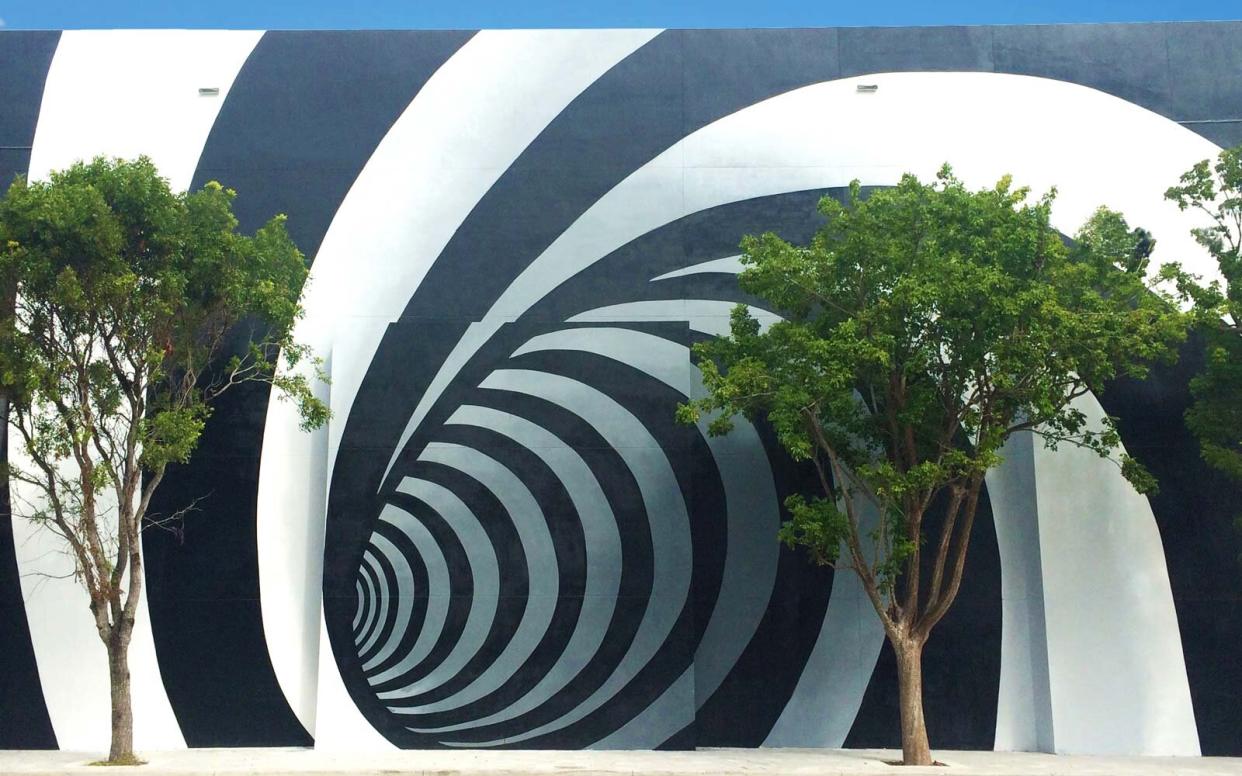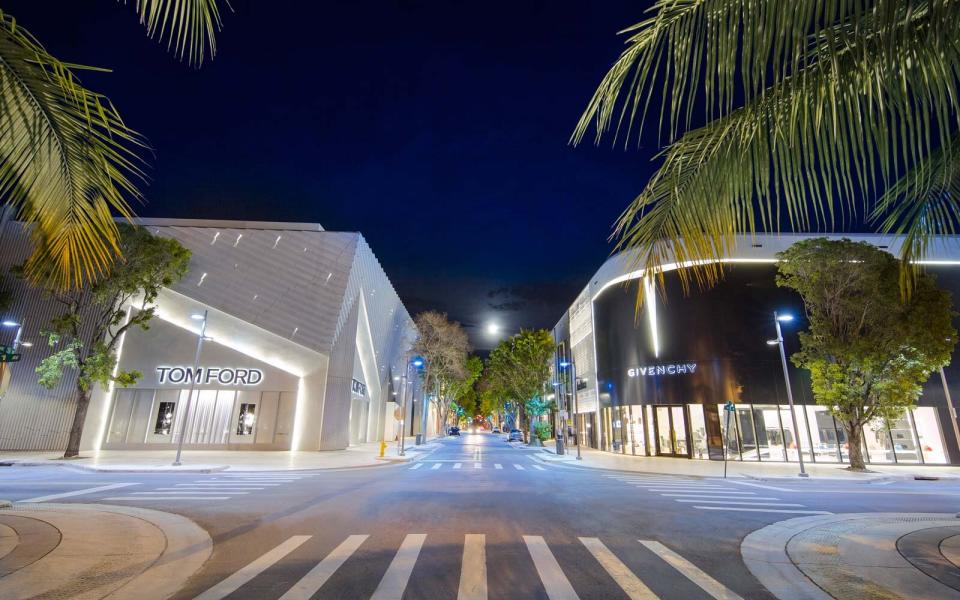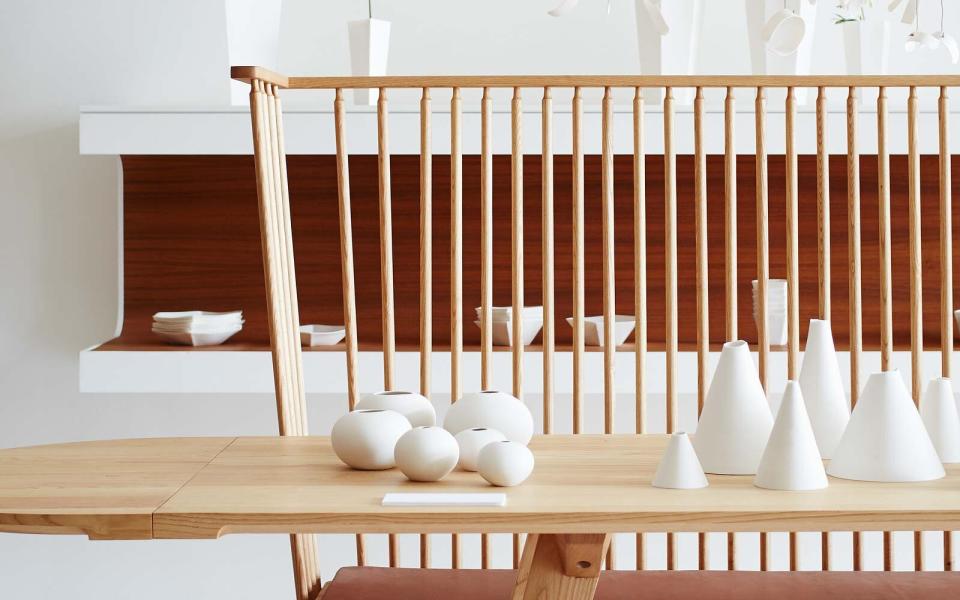The Rise of the Global Design District

Lala Pereira/Courtesy of Miami Design District Vortex, a mural in the Miami Design District by the New York–based Studio 2x4.
One fine morning a year or two ago, at an open-air counter in the Maboneng precinct of Johannesburg, South Africa, an elegant lady served me one of the world's more perfect cappuccinos. In the willfully sentimental way of travelers in search of stories, I imagined a whole biography for her — maybe she'd brought her family's La Marzocco machine all the way from Rome in a steamer trunk.
With its dour fortified compounds, Brutalist skyscrapers, and acrid mine-tailing hills, Johannesburg doesn't beguile the visitor like its relentlessly picturesque counterpart, Cape Town. So in Maboneng I was glad to find galleries, food trucks, sidewalk cafés, street art, cool cars, an artisanal craft market, the David Adjaye–designed Hallmark House hotel, and the Museum of African Design (located in a former auto-body shop). A sign bearing the name of the neighborhood swung in a graceful catenary curve, exactly like the famous one in Venice Beach, California.

Christian Science Monitor/Getty Images The Maboneng District of Johannesburg.
Feeling caffeinated and expansive, I remarked to the coffee lady on Maboneng's charm. Thank you, she said, because her son had developed pretty much all of it. Some days she liked to sit at the coffee stand just to keep an eye on things.
Maboneng is what has increasingly come to be known as a design district — a contemporary destination neighborhood that is often driven by a private property developer (or a public-private partnership).
Typically, such enclaves result from concerted efforts to reanimate historic but moribund industrial areas around the idea of design, to the theoretical delight of visitors and investors alike. Their precursors are the so-called festival marketplaces of the 1960s, '70s, and '80s, exemplified by San Francisco's Ghirardelli Square, Boston's Faneuil Hall, and New York City's South Street Seaport — redevelopment projects that brought fern bars and knickknack emporiums to 18th and 19th-century port and industrial buildings, and new life to urban centers that had emptied out in the previous decades. A more bottom-up precedent for such adaptive reuse is New York City's SoHo, whose good architectural bones inspired 1970s artists to pioneer a new kind of urban homesteading — unleashing the kind of gentrification that turns taxi garages into art galleries into luxury boutiques.
What's with the design in design district? The phrase comes from the name given in the 1980s to a section of Miami's Buena Vista neighborhood. By the 1990s, this precinct of furniture and home-décor showrooms and warehouses had grown desolate, while the more picturesque strip of Art Deco hotels and residences along nearby Ocean Drive was undergoing a revival.

Richard Patterson/Courtesy of Miami Design District
It became what we now know as the Miami Design District in 2005, when the developer Craig Robins bought up buildings across an 18-square-block area, persuaded purveyors of upscale furniture and housewares to open stores there, and helped establish Design Miami, a decorative-arts sideshow to the annual Art Basel Miami art fair. This cultural curatorship transformed the area into a fashionable hangout with round-the-clock street life. More recently, it has become a deluxe shopping zone with boutiques from Bulgari to Berluti, Céline to Cartier, many built by noteworthy architects like Sou Fujimoto, and pedigreed installations like a reproduction of the Fly's Eye Dome by the mid-20th-century design visionary R. Buckminster Fuller.
Variations on this model — sometimes consisting of little more than the word design dropped onto a map — have since been applied to the development of scruffy-to-chic precincts around the world, from the Junction in Toronto and Surry Hills in Sydney to Shoreditch in London and the once-unpromising blocks between the railroad tracks and the river in Dallas.
A few years ago, when Buenos Aires needed something to do with its old fish market at the edge of town, the city renamed it the Metropolitan Design Center — turning the stalls into incubator spaces for start-ups in fashion, graphics, and related fields, and deciding that the gritty surrounding neighborhood of Barracas would now be known as the Distrito de Dise?o.

Michael Graydon and Nikole Herriott
When Miami's Design District got its name, the word design wasn't yet all that glamorous: it still connoted the service professions of the decorative arts, the technical tedium of civil engineering, the solemn expertise of architecture and urbanism. But today we often say design as a more substantial-feeling substitute for style. Now, design gets deployed to connote a certain kind of worldly sophistication and in-the-know cool, in which "creative" is a noun and "influencer" is a job. It offers a reassuringly tasteful curatorial sensibility, with all the seeming cleverness of the art world, minus the arcane impenetrability and aura of madness.
To the traveler, the design district offers both delights and dilemmas. At best, it gets you off the beaten path, offering a kind of to-the-trade, behind-the-scenes look at the studios and showrooms where creative people aren't trying to sell you on anything, but are busy selling — and inspiring — one another. At worst, it leaves you stuck in style — in a global Brooklyn where the same digitally distributed hipsterish aesthetic is always available for purchase — wondering whether you've left one bubble for another.
Carrying my cooling cappuccino in its smartly branded paper cup along Maboneng's main drag, I thought it over. The precinct's revival might have been wholly strategized, and commercially as well as culturally driven, but its effect was real and inspiring, clearly animating the lives of locals, not just tourists. Next to the stuff you could find anywhere was stuff you could find only there — especially fashions and fabrics with their own regional vision and vernacular heritage.
On the neighborhood map, the district's boundaries appear sharply drawn, but as I walked along them, I found something more open-ended. Certain features, like the private security services so visible throughout much of Johannesburg, faded out a little, but the perimeter was also full of lively businesses and crowded sidewalks that weren't necessarily part of anyone's master plan.
The district had catalyzed more than just aesthetic expression. Design, unlike style, isn't a matter of perfect visualization and control: it's a choreography between planned and unplanned, invention and discovery, top-down and bottom-up, generic and specific, synthetic and organic. Walking the edges of Maboneng is a reminder that it's at the complicated border of any design district that the real work of urban design begins.